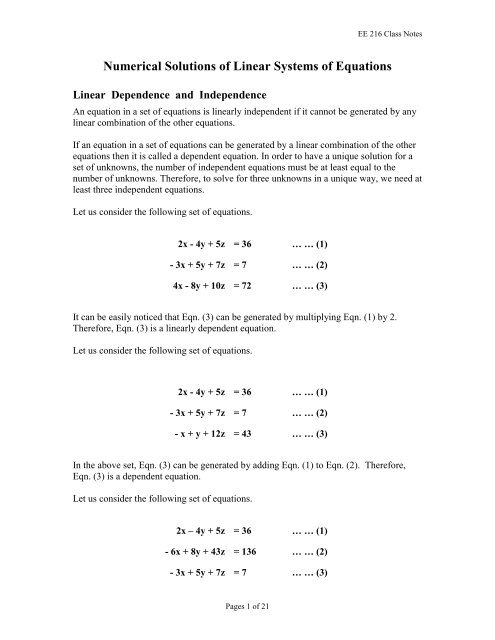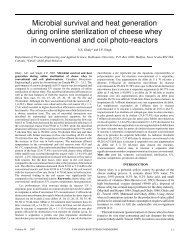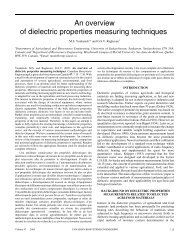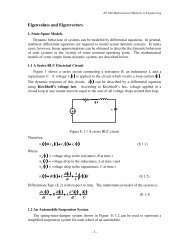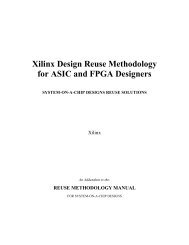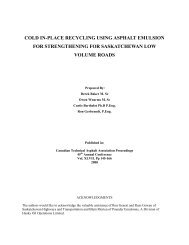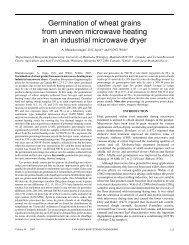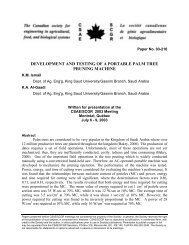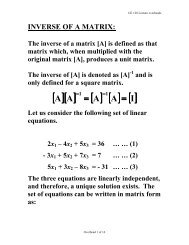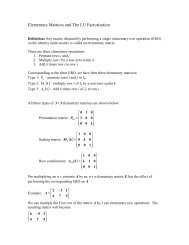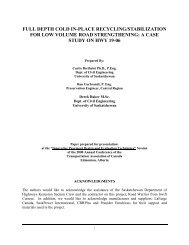Numerical Solutions of Linear Systems of Equations
Numerical Solutions of Linear Systems of Equations
Numerical Solutions of Linear Systems of Equations
Create successful ePaper yourself
Turn your PDF publications into a flip-book with our unique Google optimized e-Paper software.
EE 216 Class NotesGAUSS ELIMINATIONThe operations in the Gauss elimination are called elementary operations.Elementary operations for equations are:(I)(II)(III)Interchange <strong>of</strong> two equations.Multiplication <strong>of</strong> an equation by a nonzero constant.Addition <strong>of</strong> a constant multiple <strong>of</strong> one equation to another equation.Let us consider the set <strong>of</strong> linearly independent equations.2x - 4y + 5z = 36 … … (1)- 3x + 5y + 7z = 7 … … (2)5x + 3y - 8z = - 31 … … (3)Augmented matrix for the set is:⎛⎜⎜⎜⎝2− 35− 45357− 836 ⎞7− 31⎟⎟⎟⎠Step 1Eliminate x from the 2 nd and 3 rd equation.3R ′ +22→ R1R25R ′ → − +23R1R3Pages 3 <strong>of</strong> 21
EE 216 Class NotesFrom Row 3, 176z = -704Therefore, z = - 704/176 = - 4From Row 2, 19y – 2z = 103or, 19y – 2 (- 4) = 103or, y = 5From Row 1, - 4x + 3y + 2z = -5or, - 4x + 3 (5) + 2 (- 4) = -5or, x = 3Elementary operations for equations and matrices are:(I)(II)(III)Interchange <strong>of</strong> two equations.Multiplication <strong>of</strong> an equation by a nonzero constant.Addition <strong>of</strong> a constant multiple <strong>of</strong> one equation to another equation.When would you interchange two equations (rows)?Let us consider the following set <strong>of</strong> equations.3y + 2z = 16 … … (1)4x + 2y - 3z = - 10 … … (2)3x + 4y + z = 9 … … (3)The corresponding augmented matrix is:⎛04⎜⎜⎜⎝33242− 3116⎞− 109⎟⎟⎟⎠Pages 6 <strong>of</strong> 21
EE 216 Class NotesEqn. (1) (Row 1) cannot be used to eliminate x from Eqns. (2) and (3) (Rows 2 and 3).Interchange Row 1 with Row 2.The augmented matrix becomes:⎛40⎜⎜⎜⎝3234− 321− 10⎞169⎟⎟⎟⎠Now follow the steps mentioned earlier to solve for the unknowns.The solution is:x = - 3y = 4z = 2Let us consider the following set <strong>of</strong> linear equations.2x 1 – 4x 2 + 5x 3 = 36 … … (1)- 3x 1 + 5x 2 + 7x 3 = 7 … … (2)5x 1 + 3x 2 – 8x 3 = - 31 … … (3)Gauss elimination suggests doing elementary row operations from top to bottom. Aslightly modified form, known as Gauss-Jordan elimination suggests doing elementaryrow operations from bottom to top as well.Pages 7 <strong>of</strong> 21
EE 216 Class NotesPages 8 <strong>of</strong> 21⎥⎥⎥⎥⎥⎥⎦⎤⎢⎢⎢⎢⎢⎢⎣⎡−−−−317368357535423132122523RRRRRR +→ −′+→′⎥⎥⎥⎥⎥⎥⎦⎤⎢⎢⎢⎢⎢⎢⎣⎡−−−- 12161362411302291054233131 RR →′⎥⎥⎥⎥⎥⎥⎦⎤⎢⎢⎢⎢⎢⎢⎣⎡−−−- 121/13613626411022910542323 RRR +→′⎥⎥⎥⎥⎥⎥⎦⎤⎢⎢⎢⎢⎢⎢⎣⎡−−672/1361361316800229105423316813 RR →′⎥⎥⎥⎥⎥⎥⎦⎤⎢⎢⎢⎢⎢⎢⎣⎡−−46136100229105423223112295 RRRRRR−→′−→′⎥⎥⎥⎥⎥⎥⎦⎤⎢⎢⎢⎢⎢⎢⎣⎡−−4316100010042
EE 216 Class NoteswhereD =aaa112131aaa122232aaa132333D =1bbb123aaa122232aaa132333D =2aaa112131bbb123aaa132333D =3aaa112131aaa122232bbb123Let us consider the following set <strong>of</strong> linear equations.2x 1 – 4x 2 + 5x 3 = 36 … … (1)- 3x 1 + 5x 2 + 7x 3 = 7 … … (2)5x 1 + 3x 2 – 8x 3 = - 31 … … (3)[A][x] = [B]where[ A]=⎡−⎢⎢⎢⎣235− 4535⎤7− 8⎥⎥⎥⎦⎡ x⎢⎢⎢⎣x1⎤⎥⎥⎥⎦[ x]= x and [ B]23=⎡ 36⎤7⎢⎢⎢⎣−31⎥⎥⎥⎦Pages 11 <strong>of</strong> 21
EE 216 Class NotesD =2− 35− 45357− 8= −33636 − 4 5D1 = 7 5 7 = − 672− 31 3 − 82 36 5D2= − 3 7 7 = 10085 − 31 − 82 − 4 36D3 = − 3 5 7 = −13445 3 − 31x− 672− 33611= == DD2xx1008− 33622= = −= DD= DD− 1344=− 33633=43Pages 12 <strong>of</strong> 21
EE 216 Class NotesSolve the following set <strong>of</strong> linear equations.x 1 + x 2 + x 3 = 2 … … (1)2x 1 + 5x 2 + 3x 3 = 11 … … (2)- x 1 + 2x 2 + x 3 = 3 … … (3)Solution by Matrix InversionConsider the following set <strong>of</strong> linear equations.a =11x1+ a12x2+ a13x3b1a =21x1+ a22x2+ a23x3b2a =31x1+ a32x2+ a33x3b3… … (1)… … (2)… … (3)The system <strong>of</strong> equations above can be written in matrix form as:⎡aa⎢⎢⎢⎣a112131aaa122232aaa132333⎤ ⎡ xx⎥⎥⎥⎦ ⎢⎢⎢⎣x123⎤⎥⎥⎥⎦=⎡bb⎢⎢⎢⎣b123⎤⎥⎥⎥⎦[A][x] = [B]where[ A]=⎡aa⎢⎢⎢⎣a112131aaa122232aaa132333⎤⎥⎥⎥⎦Pages 13 <strong>of</strong> 21
EE 216 Class Notes⎡ x⎢⎢⎢⎣x1⎤⎥⎥⎥⎦[ x] = x and [ B]23=⎡bb⎢⎢⎢⎣b123⎤⎥⎥⎥⎦If D ≠ 0 , then the system has a unique solution.[x] = [A] -1 [B]A Traffic Light AssemblyzCDA6 m4 mhB3 mx4 m3 m4 m6 m4 m3 myFigure 1.1 A traffic light assemblyThe mass <strong>of</strong> the traffic light assembly is 20 kg and h = 3.5 m. For equilibrium,the forces acting on the light assembly in all three directions (x, y and z) should equal tozero.∑ x∑ y∑ zF = 0 , F = 0 and F = 0Pages 14 <strong>of</strong> 21
EE 216 Class NotesBased on the above, a set <strong>of</strong> equations in terms <strong>of</strong> the three unknown forces canbe written as:0 .5970F− 0.8381F+ 0.7960F= 0AB0 .7960F− 0.4191F− 0.5970F= 0AB0 .0995F0.3492F+ 0.0995F= 196.2ACACAB+ACADADAD… … (1)… … (2)… … (3)[A][F] = [B]where[ A ]⎡0.5970= 0.7960⎢⎢⎢⎣0.0995− 0.8381− 0.41910.34920.7960⎤− 0.59700.0995⎥⎥⎥⎦⎡F⎢⎢⎢⎣FAB⎤⎥⎥⎥⎦[ F ] = F and [ B]ACAD[ F ] = [A]−1 [ B]=⎡ 0⎤0⎢⎢⎢⎣196.2⎥⎥⎥⎦[ ]−A 1=⎡−⎢⎢⎢⎣0.35470.29480.67990.7685− 0.0421− 0.62071.7737⎤2.10560.8867⎥⎥⎥⎦[ F ]=⎡−⎢⎢⎢⎣0.35470.29480.67990.7685− 0.0421− 0.62071.7737⎤⎡ 0⎤2.1056 00.8867⎥⎥⎥⎦ ⎢⎢⎢⎣196.2⎥⎥⎥⎦Pages 15 <strong>of</strong> 21
EE 216 Class Notes[ F ]⎡F= F⎢⎢⎢⎣FABACAD⎤ ⎡347.997⎤= 413.126⎥⎥⎥⎦ ⎢⎢⎢⎣173.978⎥⎥⎥⎦Therefore, F AB = 347.997 N, F AC = 413.126 N and F AD = 173.978 NAn Electrical CircuitBased on the principles <strong>of</strong> voltage drops (Kirch<strong>of</strong>f’s voltage law) and current flow(Kirch<strong>of</strong>f’s current law), the following equations can be written in terms <strong>of</strong> the unknowncurrent flow.20 ohms 15 ohmsI 1I 280 V+-12 ohmsI 3+-120 VFigure 2.1 An electrical circuit20I 1+ 12I3= 80 … … (2.1)15I 2+ 12I3= 120 … … (2.2)I + I − I 0 … … (2.3)1 2 3=The set <strong>of</strong> equations can be solved by substitution method in the following manner.Pages 16 <strong>of</strong> 21
EE 216 Class Notes[A][C] = [B]where[ A ]=⎡200⎢⎢⎢⎣ 1015112⎤12− 1⎥⎥⎥⎦⎡I⎢⎢⎢⎣I1⎤⎥⎥⎥⎦[ C ] = I and [ B][ C ] = [A]−1 [ B]23⎡ 80⎤= 120⎢⎢⎢⎣ 0⎥⎥⎥⎦[ ]−A 1[ C ]==⎡−⎢⎢⎢⎣⎡−⎢⎢⎢⎣0.03750.01670.02080.03750.01670.0208− 0.01670.04440.0278− 0.01670.04440.02780.2500⎤0.3333− 0.4167⎥⎥⎥⎦0.2500⎤⎡ 80⎤0.3333 120− 0.4167⎥⎥⎥⎦ ⎢⎢⎢⎣ 0⎥⎥⎥⎦[ C]=⎡II⎢⎢⎢⎣I123⎤⎥⎥⎥⎦=⎡1⎤4⎢⎢⎢⎣5⎥⎥⎥⎦Therefore, I 1 = 1 A, I 2 = 4 A and I 3 = 5 A.Pages 17 <strong>of</strong> 21
EE 216 Class NotesFlow Through a Piping Networkd = 0.5 mL = 150 md = 0.5 mL = 300 mBd = 0.5 mL = 300 mD0.09 m 3 /s0.03 m 3 /sAd = 0.75 mL = 300 md = 0.75 mL = 300 md = 0.5 mL = 150 mCd = 0.5 mL = 300 m0.06 m 3 /sd = 0.75 mL = 300 mFigure 3.1 A piping networkA set <strong>of</strong> equations can be written based on the following principles:1. At each junction, flow in = flow out.2. Kinetic energy and potential energy <strong>of</strong> the fluid makes the fluid movethrough the piping network.3. For a given fluid flow, the velocity increases and the pressure decreaseswhen the pipe diameter is decreased.4. Frictional loss is directly proportional to the length <strong>of</strong> the pipe and theviscosity <strong>of</strong> the fluid and inversely proportional to the diameter <strong>of</strong> the pipe.A set <strong>of</strong> equations as functions <strong>of</strong> the five unknown flow rates can be written as:Q Q = 0.03 … … (3.1)AB+ AC− Q + Q + Q = 0.06 … … (3.2)ACABCBCD+ QCB− QBD= 0Q … … (3.3)29 .9 − 29.9Q− 3.9Q= 0Q … … (3.4)ABACCB3 .9 − 7.9Q+ 19.9Q= 0Q … … (3.5)CBCDBDPages 18 <strong>of</strong> 21
EE 216 Class NotesIt should be noted that Eqns. (3.1) – (3.3) have been derived based on the principle <strong>of</strong>conservation <strong>of</strong> mass. Eqns. (3.4) and (3.5) have been derived based on the principle <strong>of</strong>pressure drop along pipe sections.The set <strong>of</strong> equations can be solved by substitution method in the following manner.[A][Q] = [B]where[ A ]=⎡ 10129.9⎢⎢⎢⎢⎢⎢⎣ 01− 10− 29.90011− 3.93.90100− 7.90⎤0− 1019.9⎥⎥⎥⎥⎥⎥⎦⎡QQQ⎢⎢⎢⎢⎢⎢⎣QABAC⎤⎥⎥⎥⎥⎥⎥⎦[ Q] = Q and [ B]CBCDBD[ Q]= [A]−1 [ B]⎡0.03⎤0.06= 00⎢⎢⎢⎢⎢⎢⎣ 0⎥⎥⎥⎥⎥⎥⎦Pages 19 <strong>of</strong> 21
EE 216 Class Notes[ ]−A 1⎡ 0.48830.5117= − 0.1790.6907⎢⎢⎢⎢⎢⎢⎣ 0.30930.0154− 0.01540.23570.74890.25110.0387− 0.03870.5938− 0.6325− 0.36750.0158− 0.0158− 0.0139− 0.00190.00190.0019⎤− 0.00190.0298− 0.03180.0318⎥⎥⎥⎥⎥⎥⎦[ Q]=⎡ 0.48830.5117− 0.1790.6907⎢⎢⎢⎢⎢⎢⎣ 0.30930.0154− 0.01540.23570.74890.25110.0387− 0.03870.5938− 0.6325− 0.36750.0158− 0.0158− 0.0139− 0.00190.00190.0019⎤⎡0.03⎤− 0.0019 0.060.0298 0− 0.0318 00.0318⎥⎥⎥⎥⎥⎥⎦ ⎢⎢⎢⎢⎢⎢⎣ 0⎥⎥⎥⎥⎥⎥⎦[ Q]⎡QQ= QQ⎢⎢⎢⎢⎢⎢⎣QABACCBCDBD⎤ ⎡0.0156⎤0.0144= 0.00870.0657⎥⎥⎥⎥⎥⎥⎦ ⎢⎢⎢⎢⎢⎢⎣0.0243⎥⎥⎥⎥⎥⎥⎦Therefore,Q AB = 0.0156 m 3 /s, Q AC = 0.0144 m 3 /sQ CB = 0.0087 m 3 /s, Q CD = 0.0657 m 3 /sQ BD = 0.0243 m 3 /sPages 20 <strong>of</strong> 21
EE 216 Class NotesSolve the following set <strong>of</strong> linear equations.x 1 + x 2 + x 3 = 2 … … (1)2x 1 + 5x 2 + 3x 3 = 11 … … (2)- x 1 + 2x 2 + x 3 = 3 … … (3)Exercise SetsSolve the following sets <strong>of</strong> linear equations by Gaussian elimination, Gauss-Jordanelimination, Cramer’s rule and matrix inversion.(1)4x − x + x = 8(2)2x1112+ 5xx + 2x223+ 2x+ 4x33= 3= 11x − x13x112− 3xx + x2+ 3x23+ x3= 2= −1= 3(3)1x41x31x21111+ x51+ x4+ x2221+ x61+ x5+ 2x333= 8= 9= 8(4)2x11− x1− 3xx + x2+ x22− x+ x33= 4− 3x3= 6= 5(5)2x + 3x− x = 4(6)112x1− 2x2+ x3= 6x −12x+ 5x= 102332x− x1= −1x1+ x2+ 3x3= 03x+ 3x+ 5x= 412+ x233#21


